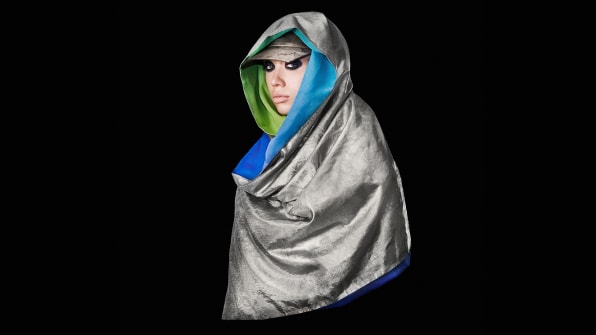Design Your Own Irish Dance Dress Game
"Look at this thing: It's like a Sealy mattress."
Deep inside a Victoria's Secret store–one of two within a block of each other on this stretch of Broadway in downtown Manhattan–Michelle Lam is holding up a sea-green push-up bra. As two white-haired women nearby puzzle over offerings from the Fabulous by Victoria's Secret collection and a twentysomething paws through a bin of thongs (five for $26.50), Lam squeezes the mound of padding, looking simultaneously disgusted and excited. Lam, 35, is the founder of True&Co., an online retailer that's using the power of data to improve the bra-shopping experience for women. Today's field trip counts as opposition research: Victoria's Secret accounts for more than half of the $11 billion U.S. intimate apparel market. According to True&Co.'s data, however, only one in five women is actually looking for the kind of bras that Victoria's Secret is selling–which to Lam represents an opportunity as big as the cleavage staring down at us from photographs on all sides. True&Co. wants women "to look at themselves in the mirror and feel like the most beautiful version of themselves, which is what a beautiful bra does," she says, pointing to a photo of a Victoria's Secret Angel. "That's not every woman's definition of beauty."
Read more
Beautify Your Closet And Get Out The Door Quicker

Beautify Your Closet And Get Out The Door Quicker
Cliq
Flow Design
"No one needs new hangers," says Georg Dwalischwili, cofounder of Latvia-based firm Flow Design, who calls the category, in general, "too boring." That might explain why the Cliq looks more like a futuristic boomerang than a closet utility. While interning at a fashion company, Dwalischwili collected old hangers from men across the country, along with their grievances, including the hangers' constant tangling and falling onto the floor. After 10 prototypes, he landed on the Cliq, which holds about 4 pounds and is girded by a magnet (instead of a hook) that allows it to glide smoothly, but securely, across a metal rod. The couture Cliq, which is purchased in sets of three for about $130, is one pricey step closer to a decluttered closet–and, perhaps, getting to work on time in the morning.
Flaunt Your Fashion–Every Single Scrap Of It

Flaunt Your Fashion–Every Single Scrap Of It
Zero-Waste Design
Daniel Silverstein
The garment industry dumps millions of tons of textiles into landfills each year–something New York–based designer Daniel Silverstein didn't realize until his first job (at a major retailer). As a student at the Fashion Institute of Technology, he was introduced to a concept called zero-waste design, which repurposes unused fabric on a garment instead of trashing it. Now he incorporates the technique in each collection. One solution, for example, is called spining, in which he snips fabric into strips and uses them to thread seams. "It's important to show the consumer they don't have to sacrifice style to change their habits," he says.
Futuristic Fashion Hides Your Curves (And Everything Else) From The NSA

Futuristic Fashion Hides Your Curves (And Everything Else) From The NSA
Stealth Wear
Adam Harvey
The Snowden leaks didn't just affect how we behave on the Internet–they're also changing the way we think about what we wear. Last year, fashion designer Adam Harvey, inspired by society's mounting concerns over privacy, presented a collection called Stealth Wear for the online mag Primitive London. The pieces–which include a $2,500 burqa that builds on the Islamic principle of keeping a layer between mankind and God–have a silver lining that confuses surveillance cameras that capture heat signatures. "It's a fashion statement to say you're disconnected," says Harvey, who sells the gear through his web store (The Privacy Gift Shop).
Cyborgs Won't Be The Only Ones To Love Next-Gen Wearables

Cyborgs Won't Be The Only Ones To Love Next-Gen Wearables
Samsung takes on the thorny design challenge of building an intimate, fashionable, wearable computer.
Samsung
"Why don't we take you into the war room?"
Dennis Miloseski leads me into a small conference room with hundreds of images tacked on the walls, mostly sketches of thin, hollow cylinders, but also a smattering of pictures–a beautiful woman, a delicate silver bangle. Some of the drawings have functions written above them in block letters–HAPTIC FEEDBACK, one says–along with dozens of red and green stickers to indicate whether those ideas have been abandoned or embraced. On a central table, there are maybe 50 models made out of cardboard, plastic, and metal neatly lined up next to a tangle of circuit boards.
The finished product sits on Miloseski's right wrist, a gorgeous watch that features a slender, curved screen. The $199 device, which went on sale in April, tracks his heart rate and movement during the day and his sleep patterns at night, while allowing him to see incoming emails and texts without taking out his phone. He unsnaps it and hands it to me, proudly pointing to a tiny series of numbers printed on the watch face: 2 of 70. No. 1 is apparently somewhere in Korea. "This was the first batch that came off the assembly line," he says. "We wanted to create that feeling of Wow, I haven't seen that before."
Read more
Borrowing Is The New Owning

Hyman started with high-end gowns but now wants to rent you items for your entire home.Photo: Andy Ryan
Borrowing Is The New Owning
Rent the Runway
Jennifer Hyman
Since its 2009 launch, Rent the Runway has been loaning out designer dresses to customers at 10% of their retail price. In 2010, the company expanded its offerings to include purses, scarves, and other accessories–a move that has helped orders double over the past year. Now cofounder and CEO Jennifer Hyman is hoping to conquer both the Netflix and Amazon models with a new rental subscription service and a vision to one day offer everything a person could ever need..
Read more
Preppers Get In Fashion

Preppers Get In Fashion
Doomsday Jacket
Marie-Elsa Batteux
Consider it an investment piece for those freezing temperatures after nuclear fallout. As research for her thesis at the Netherlands-based Eindhoven Design Academy, French designer Marie-Elsa Batteux immersed herself in the "prepper" movement–yes, the folks who stock their basements with canned goods and powdered foods–and imagined what type of clothing might be needed for an actual apocalypse, covering everything from catastrophic war to biblical flood. The result is the Doomsday Jacket, a garment that gives utilitarian fashion a radical new meaning–but could also provide a blueprint for clothing in the far-off future. "Preppers have a bit of a bad image, and I wanted to make it more acceptable," says Batteux. "Every feature is folded into the jacket, but it remains totally wearable and doesn't look completely freaky."
-
Food:
Water and food rations are safely stocked in an interior pocket to tide survivors over until sustenance can be found.
-
Weapons:
The elbows of the jacket sheathe sharp, ninjalike blades for self-defense.
-
Flotation:
Balloonlike devices (and neon-colored flaps) are embedded in the jacket at the shoulders, hips, and underarms. In the event of melting ice caps, a wearer can wade his way to safety.
-
Respiration:
An oxygen mask and eye protector unroll from the hood to shield the wearer's face from airborne chemicals or debris.
-
Warmth:
In the case of a nuclear winter, a space blanket unfurls from the lining.
Design Your Own Irish Dance Dress Game
Source: https://www.fastcompany.com/90181652/design-is-changing-how-we-dress-2
Posted by: bakersalogned.blogspot.com

0 Response to "Design Your Own Irish Dance Dress Game"
Post a Comment